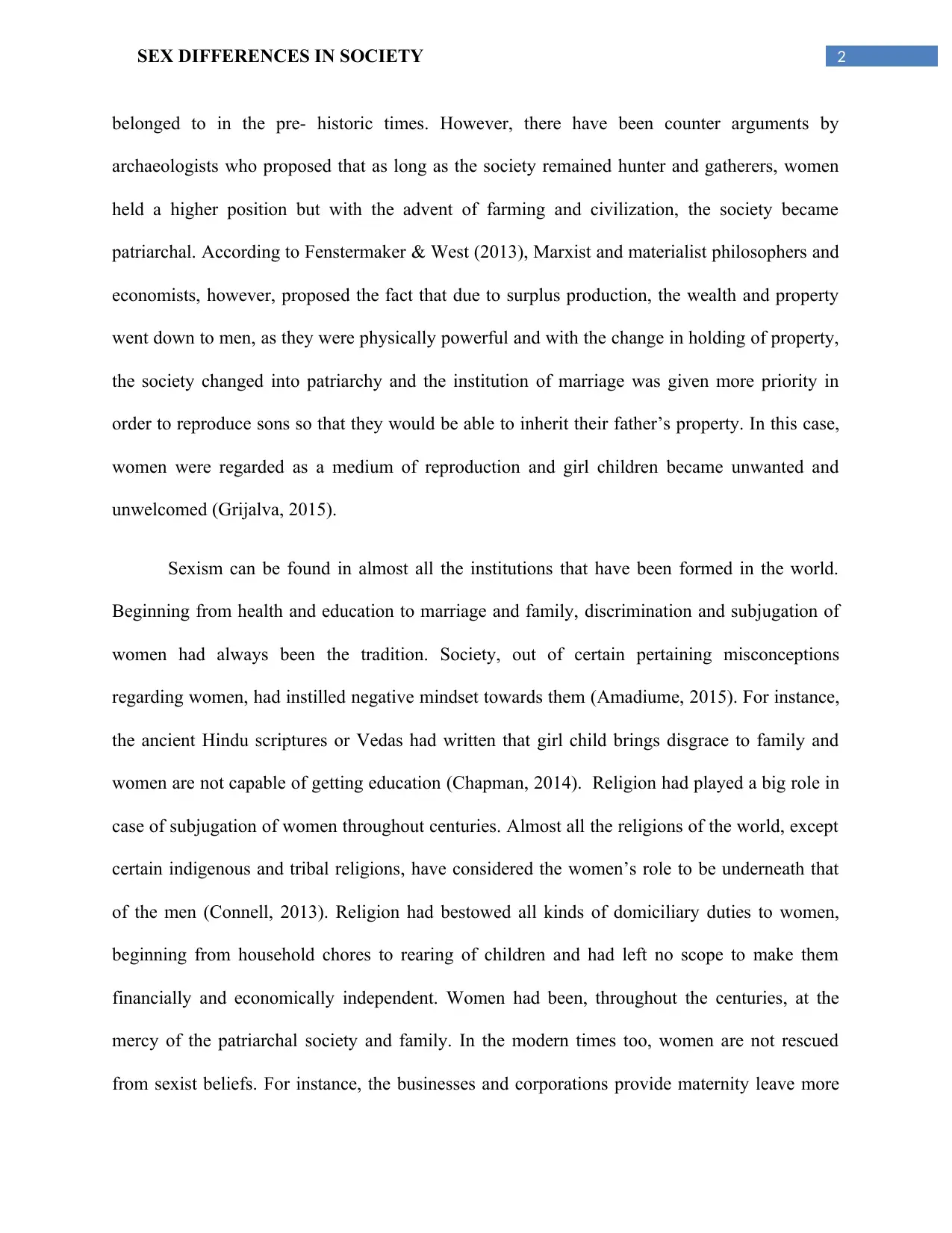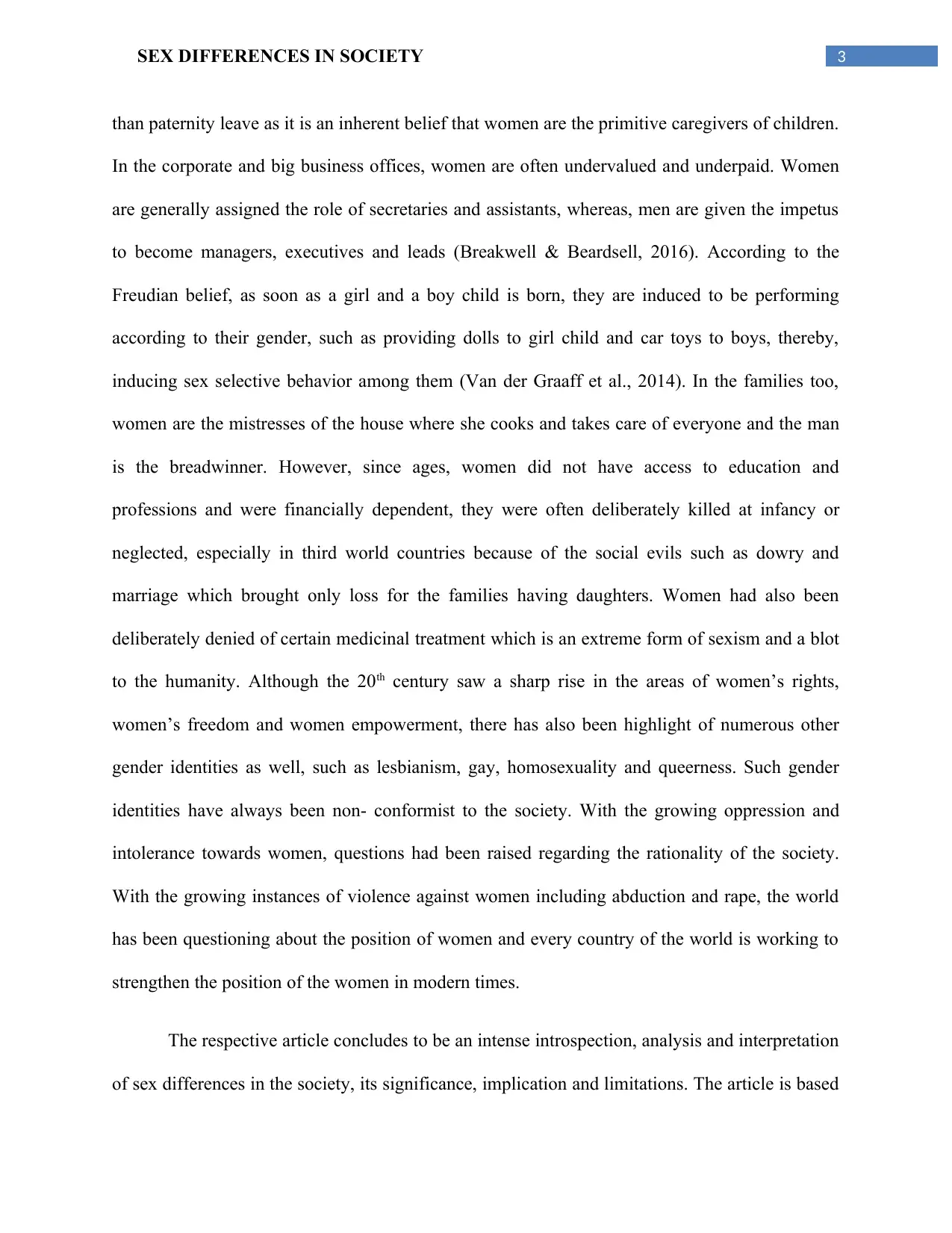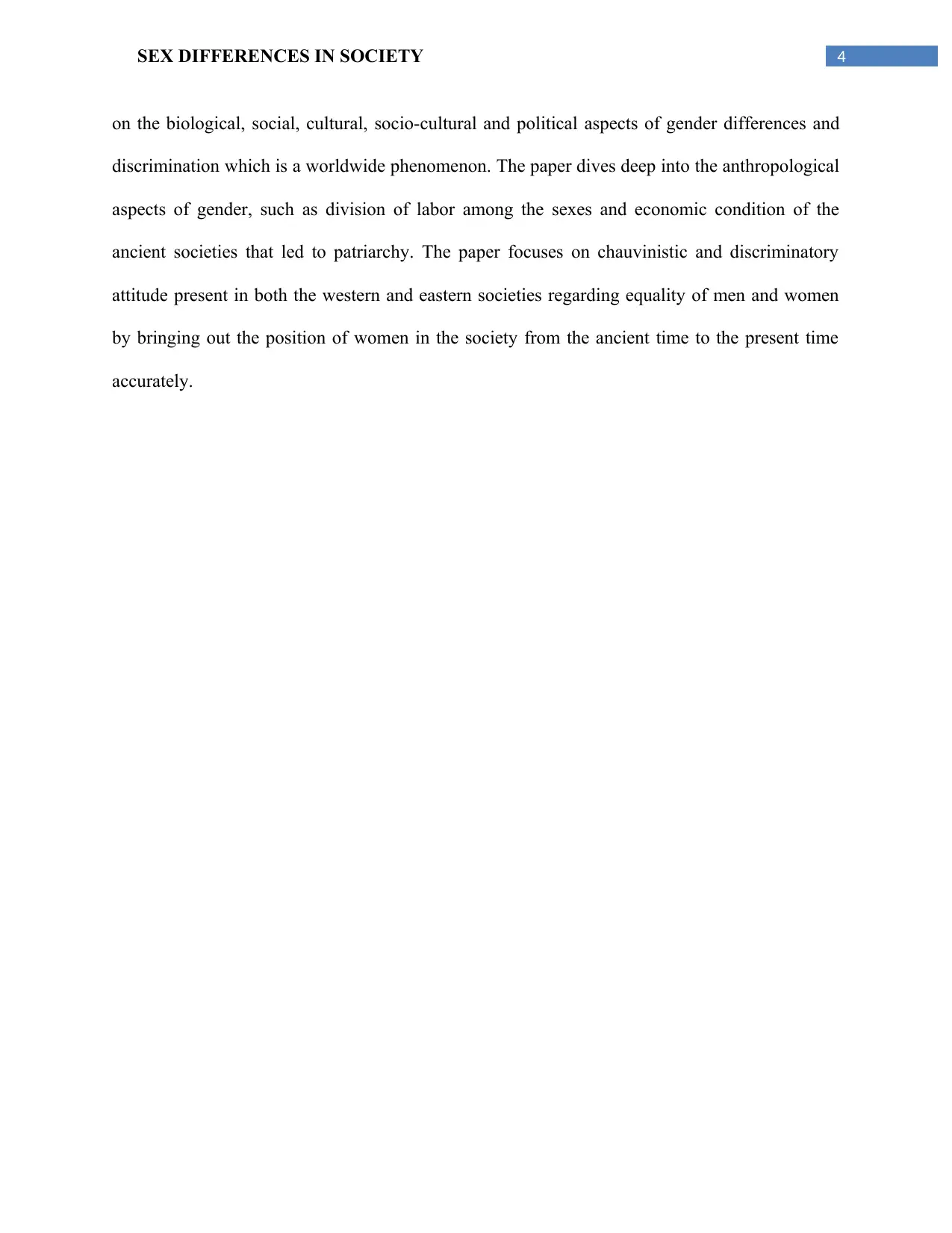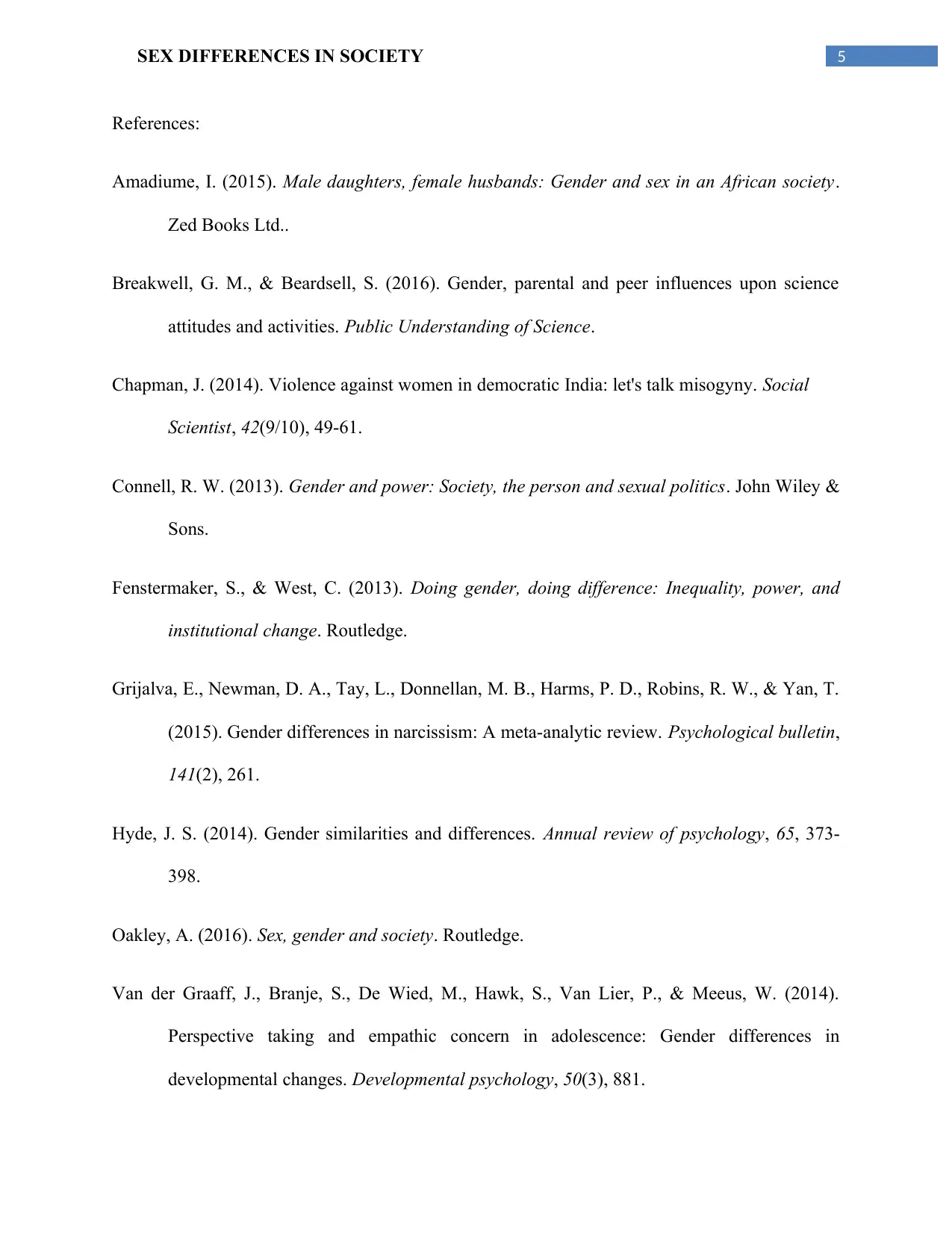Comprehensive Study: Sex Differences in Society and Culture
VerifiedAdded on 2022/10/15
|6
|1541
|18
Essay
AI Summary
This essay provides an in-depth analysis of sex differences in society, exploring the biological, social, cultural, and political aspects of gender. It examines gender roles, discrimination, and the historical context of patriarchy. The essay delves into how sexism manifests across various institutions, including medicine, education, and the workplace, and discusses the impact of religious beliefs and cultural norms on women's roles. It also addresses the emergence of different gender identities and the ongoing fight for women's rights and equality in the modern world, concluding with a comprehensive overview of societal challenges and the need for change.

Running head: SEX DIFFERENCES IN SOCIETY
SEX DIFFERENCES IN SOCEITY
Name of the student
Name of the university
Author Note
SEX DIFFERENCES IN SOCEITY
Name of the student
Name of the university
Author Note
Paraphrase This Document
Need a fresh take? Get an instant paraphrase of this document with our AI Paraphraser

1SEX DIFFERENCES IN SOCIETY
The respective article is an intense introspection, analysis and interpretation of sex
differences in the society, its significance, implication and limitations. The article is based on the
biological, social, cultural, socio-cultural and political aspects of gender differences and
discrimination which is a worldwide phenomenon. The paper focuses on chauvinistic and
discriminatory attitude present in both the western and eastern societies regarding equality of
men and women by bringing out the position of women in the society from the ancient time to
the present time accurately.
Gender roles can be defined as a set of believe or expectations based on their sex or
gender, and also on each society’s values based on the particular gender. Gender roles can be
deduced as a product of interaction between the individuals and environment, which provides the
individuals clue about what sort of behavior is suitable for a particular sex (Hyde, 2014). Sex
differences or gender differentiation is an age old custom of almost all the societies in the world
which has led to a patriarchal society where the power and position of a family and the state is
passed down by the fathers (the men) where women played a submissive and subordinate role
throughout the history. As the position of women in the society degraded and considered to be
inferior with that of the man, every aspect of the society, somewhat, exhibits sexism and gender
discrimination, beginning from medicine, education to economy and politics. However, it has to
be understood that differentiation was not a sudden process. Sex discrimination could be well
observed by going through the prehistoric and ancient history where the division of labor
according to the sexes could be observed (Oakley, 2016). It was assumed that the physical
complications and limitations of women set them apart and alienated from the men’s world as
men had been assumed to be having physical power more than women. Therefore, men were
given the charge to control the situations, families, societies and state or territory where they
The respective article is an intense introspection, analysis and interpretation of sex
differences in the society, its significance, implication and limitations. The article is based on the
biological, social, cultural, socio-cultural and political aspects of gender differences and
discrimination which is a worldwide phenomenon. The paper focuses on chauvinistic and
discriminatory attitude present in both the western and eastern societies regarding equality of
men and women by bringing out the position of women in the society from the ancient time to
the present time accurately.
Gender roles can be defined as a set of believe or expectations based on their sex or
gender, and also on each society’s values based on the particular gender. Gender roles can be
deduced as a product of interaction between the individuals and environment, which provides the
individuals clue about what sort of behavior is suitable for a particular sex (Hyde, 2014). Sex
differences or gender differentiation is an age old custom of almost all the societies in the world
which has led to a patriarchal society where the power and position of a family and the state is
passed down by the fathers (the men) where women played a submissive and subordinate role
throughout the history. As the position of women in the society degraded and considered to be
inferior with that of the man, every aspect of the society, somewhat, exhibits sexism and gender
discrimination, beginning from medicine, education to economy and politics. However, it has to
be understood that differentiation was not a sudden process. Sex discrimination could be well
observed by going through the prehistoric and ancient history where the division of labor
according to the sexes could be observed (Oakley, 2016). It was assumed that the physical
complications and limitations of women set them apart and alienated from the men’s world as
men had been assumed to be having physical power more than women. Therefore, men were
given the charge to control the situations, families, societies and state or territory where they

2SEX DIFFERENCES IN SOCIETY
belonged to in the pre- historic times. However, there have been counter arguments by
archaeologists who proposed that as long as the society remained hunter and gatherers, women
held a higher position but with the advent of farming and civilization, the society became
patriarchal. According to Fenstermaker & West (2013), Marxist and materialist philosophers and
economists, however, proposed the fact that due to surplus production, the wealth and property
went down to men, as they were physically powerful and with the change in holding of property,
the society changed into patriarchy and the institution of marriage was given more priority in
order to reproduce sons so that they would be able to inherit their father’s property. In this case,
women were regarded as a medium of reproduction and girl children became unwanted and
unwelcomed (Grijalva, 2015).
Sexism can be found in almost all the institutions that have been formed in the world.
Beginning from health and education to marriage and family, discrimination and subjugation of
women had always been the tradition. Society, out of certain pertaining misconceptions
regarding women, had instilled negative mindset towards them (Amadiume, 2015). For instance,
the ancient Hindu scriptures or Vedas had written that girl child brings disgrace to family and
women are not capable of getting education (Chapman, 2014). Religion had played a big role in
case of subjugation of women throughout centuries. Almost all the religions of the world, except
certain indigenous and tribal religions, have considered the women’s role to be underneath that
of the men (Connell, 2013). Religion had bestowed all kinds of domiciliary duties to women,
beginning from household chores to rearing of children and had left no scope to make them
financially and economically independent. Women had been, throughout the centuries, at the
mercy of the patriarchal society and family. In the modern times too, women are not rescued
from sexist beliefs. For instance, the businesses and corporations provide maternity leave more
belonged to in the pre- historic times. However, there have been counter arguments by
archaeologists who proposed that as long as the society remained hunter and gatherers, women
held a higher position but with the advent of farming and civilization, the society became
patriarchal. According to Fenstermaker & West (2013), Marxist and materialist philosophers and
economists, however, proposed the fact that due to surplus production, the wealth and property
went down to men, as they were physically powerful and with the change in holding of property,
the society changed into patriarchy and the institution of marriage was given more priority in
order to reproduce sons so that they would be able to inherit their father’s property. In this case,
women were regarded as a medium of reproduction and girl children became unwanted and
unwelcomed (Grijalva, 2015).
Sexism can be found in almost all the institutions that have been formed in the world.
Beginning from health and education to marriage and family, discrimination and subjugation of
women had always been the tradition. Society, out of certain pertaining misconceptions
regarding women, had instilled negative mindset towards them (Amadiume, 2015). For instance,
the ancient Hindu scriptures or Vedas had written that girl child brings disgrace to family and
women are not capable of getting education (Chapman, 2014). Religion had played a big role in
case of subjugation of women throughout centuries. Almost all the religions of the world, except
certain indigenous and tribal religions, have considered the women’s role to be underneath that
of the men (Connell, 2013). Religion had bestowed all kinds of domiciliary duties to women,
beginning from household chores to rearing of children and had left no scope to make them
financially and economically independent. Women had been, throughout the centuries, at the
mercy of the patriarchal society and family. In the modern times too, women are not rescued
from sexist beliefs. For instance, the businesses and corporations provide maternity leave more
⊘ This is a preview!⊘
Do you want full access?
Subscribe today to unlock all pages.

Trusted by 1+ million students worldwide

3SEX DIFFERENCES IN SOCIETY
than paternity leave as it is an inherent belief that women are the primitive caregivers of children.
In the corporate and big business offices, women are often undervalued and underpaid. Women
are generally assigned the role of secretaries and assistants, whereas, men are given the impetus
to become managers, executives and leads (Breakwell & Beardsell, 2016). According to the
Freudian belief, as soon as a girl and a boy child is born, they are induced to be performing
according to their gender, such as providing dolls to girl child and car toys to boys, thereby,
inducing sex selective behavior among them (Van der Graaff et al., 2014). In the families too,
women are the mistresses of the house where she cooks and takes care of everyone and the man
is the breadwinner. However, since ages, women did not have access to education and
professions and were financially dependent, they were often deliberately killed at infancy or
neglected, especially in third world countries because of the social evils such as dowry and
marriage which brought only loss for the families having daughters. Women had also been
deliberately denied of certain medicinal treatment which is an extreme form of sexism and a blot
to the humanity. Although the 20th century saw a sharp rise in the areas of women’s rights,
women’s freedom and women empowerment, there has also been highlight of numerous other
gender identities as well, such as lesbianism, gay, homosexuality and queerness. Such gender
identities have always been non- conformist to the society. With the growing oppression and
intolerance towards women, questions had been raised regarding the rationality of the society.
With the growing instances of violence against women including abduction and rape, the world
has been questioning about the position of women and every country of the world is working to
strengthen the position of the women in modern times.
The respective article concludes to be an intense introspection, analysis and interpretation
of sex differences in the society, its significance, implication and limitations. The article is based
than paternity leave as it is an inherent belief that women are the primitive caregivers of children.
In the corporate and big business offices, women are often undervalued and underpaid. Women
are generally assigned the role of secretaries and assistants, whereas, men are given the impetus
to become managers, executives and leads (Breakwell & Beardsell, 2016). According to the
Freudian belief, as soon as a girl and a boy child is born, they are induced to be performing
according to their gender, such as providing dolls to girl child and car toys to boys, thereby,
inducing sex selective behavior among them (Van der Graaff et al., 2014). In the families too,
women are the mistresses of the house where she cooks and takes care of everyone and the man
is the breadwinner. However, since ages, women did not have access to education and
professions and were financially dependent, they were often deliberately killed at infancy or
neglected, especially in third world countries because of the social evils such as dowry and
marriage which brought only loss for the families having daughters. Women had also been
deliberately denied of certain medicinal treatment which is an extreme form of sexism and a blot
to the humanity. Although the 20th century saw a sharp rise in the areas of women’s rights,
women’s freedom and women empowerment, there has also been highlight of numerous other
gender identities as well, such as lesbianism, gay, homosexuality and queerness. Such gender
identities have always been non- conformist to the society. With the growing oppression and
intolerance towards women, questions had been raised regarding the rationality of the society.
With the growing instances of violence against women including abduction and rape, the world
has been questioning about the position of women and every country of the world is working to
strengthen the position of the women in modern times.
The respective article concludes to be an intense introspection, analysis and interpretation
of sex differences in the society, its significance, implication and limitations. The article is based
Paraphrase This Document
Need a fresh take? Get an instant paraphrase of this document with our AI Paraphraser

4SEX DIFFERENCES IN SOCIETY
on the biological, social, cultural, socio-cultural and political aspects of gender differences and
discrimination which is a worldwide phenomenon. The paper dives deep into the anthropological
aspects of gender, such as division of labor among the sexes and economic condition of the
ancient societies that led to patriarchy. The paper focuses on chauvinistic and discriminatory
attitude present in both the western and eastern societies regarding equality of men and women
by bringing out the position of women in the society from the ancient time to the present time
accurately.
on the biological, social, cultural, socio-cultural and political aspects of gender differences and
discrimination which is a worldwide phenomenon. The paper dives deep into the anthropological
aspects of gender, such as division of labor among the sexes and economic condition of the
ancient societies that led to patriarchy. The paper focuses on chauvinistic and discriminatory
attitude present in both the western and eastern societies regarding equality of men and women
by bringing out the position of women in the society from the ancient time to the present time
accurately.

5SEX DIFFERENCES IN SOCIETY
References:
Amadiume, I. (2015). Male daughters, female husbands: Gender and sex in an African society.
Zed Books Ltd..
Breakwell, G. M., & Beardsell, S. (2016). Gender, parental and peer influences upon science
attitudes and activities. Public Understanding of Science.
Chapman, J. (2014). Violence against women in democratic India: let's talk misogyny. Social
Scientist, 42(9/10), 49-61.
Connell, R. W. (2013). Gender and power: Society, the person and sexual politics. John Wiley &
Sons.
Fenstermaker, S., & West, C. (2013). Doing gender, doing difference: Inequality, power, and
institutional change. Routledge.
Grijalva, E., Newman, D. A., Tay, L., Donnellan, M. B., Harms, P. D., Robins, R. W., & Yan, T.
(2015). Gender differences in narcissism: A meta-analytic review. Psychological bulletin,
141(2), 261.
Hyde, J. S. (2014). Gender similarities and differences. Annual review of psychology, 65, 373-
398.
Oakley, A. (2016). Sex, gender and society. Routledge.
Van der Graaff, J., Branje, S., De Wied, M., Hawk, S., Van Lier, P., & Meeus, W. (2014).
Perspective taking and empathic concern in adolescence: Gender differences in
developmental changes. Developmental psychology, 50(3), 881.
References:
Amadiume, I. (2015). Male daughters, female husbands: Gender and sex in an African society.
Zed Books Ltd..
Breakwell, G. M., & Beardsell, S. (2016). Gender, parental and peer influences upon science
attitudes and activities. Public Understanding of Science.
Chapman, J. (2014). Violence against women in democratic India: let's talk misogyny. Social
Scientist, 42(9/10), 49-61.
Connell, R. W. (2013). Gender and power: Society, the person and sexual politics. John Wiley &
Sons.
Fenstermaker, S., & West, C. (2013). Doing gender, doing difference: Inequality, power, and
institutional change. Routledge.
Grijalva, E., Newman, D. A., Tay, L., Donnellan, M. B., Harms, P. D., Robins, R. W., & Yan, T.
(2015). Gender differences in narcissism: A meta-analytic review. Psychological bulletin,
141(2), 261.
Hyde, J. S. (2014). Gender similarities and differences. Annual review of psychology, 65, 373-
398.
Oakley, A. (2016). Sex, gender and society. Routledge.
Van der Graaff, J., Branje, S., De Wied, M., Hawk, S., Van Lier, P., & Meeus, W. (2014).
Perspective taking and empathic concern in adolescence: Gender differences in
developmental changes. Developmental psychology, 50(3), 881.
⊘ This is a preview!⊘
Do you want full access?
Subscribe today to unlock all pages.

Trusted by 1+ million students worldwide
1 out of 6
Related Documents
Your All-in-One AI-Powered Toolkit for Academic Success.
+13062052269
info@desklib.com
Available 24*7 on WhatsApp / Email
![[object Object]](/_next/static/media/star-bottom.7253800d.svg)
Unlock your academic potential
Copyright © 2020–2025 A2Z Services. All Rights Reserved. Developed and managed by ZUCOL.





